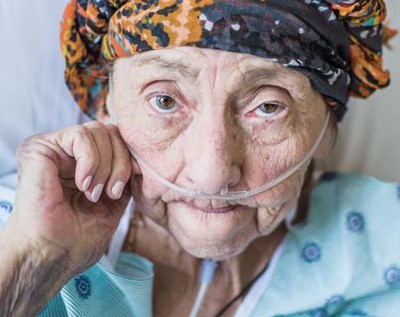Hospice Eligibility for Patients With End-Stage COPD and Other Forms of Lung Disease
Download a PDF of these guidelines.
Are you a patient, family member or caregiver? Learn about how VITAS Healthcare can help patients with end-stage COPD and other forms of lung disease.
Advanced lung disease, including chronic obstructive pulmonary disease (COPD) and other lung diseases, are among the most common conditions leading healthcare professionals to refer a patient to hospice. Understanding what makes a patient with lung disease hospice eligible is integral to providing compassionate care in their preferred care setting.
Hospice eligibility guidelines for COPD and lung disease
Physicians may use clinical guidelines to identify patients in the final six months of life from lung disease. When it comes to end-of-life care, patients should be both physiologically and psychologically hospice-appropriate.
Hospice care is designed to help patients who:
- are dyspneic at rest or with minimal exertion.
- have progressed to the point where they spend most of their days at home but do not necessarily need to be homebound.
- have experienced repeated ED visits (one or more each quarter) due to infection or episodes of respiratory failure.
- have endured a hospitalization (one or more each quarter) and no longer wish to be admitted.
VITAS counsels patients and their families about their goals and alternative ways to manage symptoms to prevent unwanted hospitalization and intubation.
Major characteristics of COPD or lung disease
- Respiratory symptom severity
- Dyspnea at rest and/or with minimal exertion while on oxygen therapy
- Dyspnea unresponsive or poorly responsive to bronchodilator therapy
- Example scenario: A 76-year-old COPD patient on continuous oxygen becomes short of breath walking across a room despite medication optimization.
- Frequency of acute exacerbations
- Progression of chronic pulmonary disease as evidenced by one or more of the following:
- Frequent use of medical services, including hospitalizations, ED visits and/or physician outpatient visits, due to symptoms of pulmonary disease
- Frequent episodes of bronchitis or pneumonia
- Example scenario: Patient with three bronchitis episodes in four months refuses further intubation.
- Progression of chronic pulmonary disease as evidenced by one or more of the following:
- Weight loss and nutritional indicators
- Unintentional weight loss of ≥ 10 percent body weight over the preceding six months
- Reduced appetite or cachexia
- Functional decline and ADL dependency
- Progressive inability to independently perform various activities of daily living (ADLs) or an increasing dependency with ADLs, resulting in a progressively lower performance status
- Activities of daily living (ADLs) include the ability to perform the following tasks without help from others:
- Bathe
- Dress
- Groom
- Move from one location to another safely
- Toilet
- Eat and drink
- Activities of daily living (ADLs) include the ability to perform the following tasks without help from others:
- Progressive inability to independently perform various activities of daily living (ADLs) or an increasing dependency with ADLs, resulting in a progressively lower performance status
- Care goals and decision to forgo curative treatment
- The patient or their healthcare proxy has elected to discontinue curative or disease-modifying treatments (e.g., mechanical ventilation, aggressive pharmacologic therapies).
- Stopping curative treatment is a core Medicare hospice requirement.
- Example scenario: A patient with progressive pulmonary fibrosis opts to stop all immunosuppressive therapy and declines future hospitalization.
- The patient or their healthcare proxy has elected to discontinue curative or disease-modifying treatments (e.g., mechanical ventilation, aggressive pharmacologic therapies).
Other clinical factors to consider for eligibility
- Cor pulmonale
- Continuous chronic oxygen therapy
- Resting tachycardia > 100/minute
- Steroid-dependent
- Cyanosis
Supportive abnormal laboratory findings
While these laboratory studies may be helpful to the clinician when considering patient appropriateness for VITAS hospice and palliative care services, they are not required for patient admission.
- FEV1 ≤ 30 percent predicted post-bronchodilator
- Serial decreases in FEV1 of at least 40 ml/year over several years
- PO2 ≤ 55 on room air
- O2 sat. ≤ 88 percent on room air
- Persistent hypercarbia (PCO2) ≥ 50 mm HG
VITAS provides these guidelines as a convenient tool. They do not take the place of a physician's professional judgment.
Types of chronic lung disease that may warrant hospice care
Hospice care focuses on making the most of life, however long that may be, by prioritizing patient comfort and addressing symptoms, including shortness of breath and pain. When curative or rehabilitative treatments are no longer effective or tolerated, and a patient’s life expectancy is six months or less, these chronic lung diseases may require hospice care:
- Chronic obstructive pulmonary disorder (COPD)
- Emphysema
- Chronic bronchitis
- Bronchiectasis
- Pulmonary fibrosis
- Cystic fibrosis
- Tuberculosis
VITAS offers a specialized hospice program for patients with end-stage COPD and other lung diseases
Dyspnea and the anxiety associated with it are two of the most distressing symptoms that lung disease patients experience. These can often be treated using a combination of clinical therapies, both pharmacologic and non-pharmacologic, as well as the individual, 24-hour support that hospice offers. The VITAS plan of care for end-stage lung disease includes:
- Comprehensive evaluation by all members of the interdisciplinary team
- Pre-emergency care planning consistent with the patient’s needs and goals
- Pharmacologic and non-pharmacologic interventions to reduce episodes of respiratory distress
- 24-hour response upon onset of respiratory distress using a customized emergency protocol
- Caregiving objectives focused on improving the patient's quality of life
Palliative care is an option to consider if your patient doesn’t currently meet the eligibility guidelines or is not ready for hospice care.

